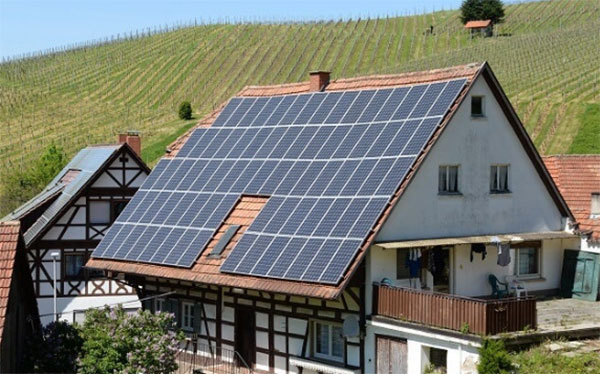
Efficiency Metrics: Comparing Solar Panels and Fossil Fuels
The discourse on energy efficiency often centers around the metrics used to gauge the performance of renewable energy sources like solar panels against conventional fossil fuels. This comparison delves into the core of energy sustainability, addressing the immediate need for cleaner, more sustainable energy solutions.
Energy Conversion Rates
The energy conversion rate is a pivotal factor in assessing the efficiency of solar panels versus fossil fuels. Solar panels, leveraging photovoltaic technology, convert sunlight into electricity with an average efficiency rate ranging from 15% to 22%. This figure is continuously improving with advancements in solar technology, as researchers are pushing the boundaries, aiming to harness a larger portion of the solar spectrum.
Fossil fuels, on the other hand, operate differently. The efficiency of fossil fuel-based power plants can vary significantly, typically ranging between 33% and 50% for coal and natural gas plants. It's crucial to acknowledge that these rates are subject to the technology used and the type of fossil fuel being consumed. Advanced gas turbine plants, for instance, can achieve efficiency levels exceeding 60%, showcasing the influence of technological evolution on efficiency metrics.
Lifetime Energy Output vs. Input
The lifetime energy output versus input ratio offers a comprehensive view of the energy production efficiency over the entire lifespan of the energy source. Solar panels stand out in this category, boasting a high energy return on investment (EROI). On average, a solar panel is capable of generating several times the energy required for its manufacture, installation, and decommissioning.
In contrast, fossil fuels present a more complex scenario. The EROI for fossil fuels has been on a declining trend, primarily due to the increasing energy expenditure in extraction processes as easily accessible reserves are depleted. Moreover, the environmental costs associated with fossil fuel extraction and combustion, though not always quantified in the EROI, add a substantial burden, underscoring the hidden inefficiencies of fossil fuels.
Environmental Impact Assessment
When debating the merits of solar panels versus fossil fuels, the environmental impact stands as a critical consideration. This assessment encompasses the repercussions on the ecosystem during the entire lifecycle of the energy source, from extraction or production to disposal or decommissioning.
Emissions during Lifecycle
Solar panels significantly reduce greenhouse gas emissions once operational, emitting nearly zero pollutants. However, the production phase is not entirely free from environmental impact. Manufacturing solar panels involves the emission of greenhouse gases and the consumption of energy, predominantly during the extraction and refining of materials like silicon. Despite this, the total greenhouse gas emissions per unit of energy generated by solar panels are markedly lower than those from fossil fuels. Coal-fired power plants, for instance, emit approximately 2.2 pounds of CO2 per kWh, while solar panels range from 0.07 to 0.2 pounds of CO2 per kWh, a stark contrast highlighting the cleaner nature of solar energy.
Fossil fuels, conversely, are notorious for their substantial emissions throughout their lifecycle. From extraction to combustion, fossil fuels release a considerable amount of greenhouse gases, notably CO2, methane, and nitrous oxide. These emissions contribute significantly to air pollution and climate change, raising concerns about their long-term viability as energy sources.
Land Use and Habitat Disruption
The land use and habitat disruption caused by energy sources is a multifaceted issue, encompassing direct and indirect environmental impacts. Solar farms require substantial land area, potentially leading to habitat loss or alteration. However, the integration of solar panels on buildings or degraded lands can mitigate these effects, showcasing solar energy's adaptability and reduced ecological footprint.

Economic Analysis: Cost-Effectiveness Over Time
The economic feasibility of energy sources is a pivotal factor driving global energy decisions. This section evaluates the cost-effectiveness of solar panels versus fossil fuels, considering the initial investment, maintenance costs, and long-term financial benefits.
Initial Investment and Maintenance Costs
Solar panels are often associated with high initial investment costs. The price of a residential solar panel system can range from $15,000 to $25,000, depending on various factors including:
- System size and power output: Larger systems with higher kW capacity cost more.
- Quality of materials: Higher efficiency panels made with premium materials come at a higher price.
- Installation complexity: Costs vary based on roof type, the angle of installation, and local labor rates.
Despite the substantial upfront cost, solar panels have relatively low maintenance costs, primarily involving periodic cleaning and occasional component replacements. Fossil fuel power plants, in contrast, entail continuous expenses for fuel procurement, operation, and maintenance, often resulting in higher operational costs over time.
Long-Term Savings and Incentives
The long-term economic benefits of solar panels are significant, especially when considering:
- Reduction in energy bills: Solar panels can drastically reduce or even eliminate electricity bills, with savings directly proportional to the size of the solar system and energy usage patterns.
- Government incentives and tax credits: Many regions offer incentives like feed-in tariffs, tax credits, or rebates to offset the initial cost of solar panel installation.
- Increased property value: Properties equipped with solar panel systems often see an increase in market value.

Technological Advancements and Efficiency Improvements
In the dynamic landscape of energy production, technological advancements play a crucial role in shaping the efficiency and viability of both solar panels and fossil fuels. This section delves into the recent innovations and trends that are influencing the efficiency metrics and operational capabilities of these energy sources.
Innovations in Solar Technology
The field of solar energy is witnessing rapid advancements, each aiming to enhance the efficiency, durability, and adaptability of solar panels:
- High-Efficiency Solar Cells: Recent developments have led to the creation of solar cells with efficiencies exceeding 22%, a significant improvement over traditional models. For instance, PERC (Passivated Emitter and Rear Cell) technology improves light capture and electron retention in the cell, boosting overall efficiency.
- Bifacial Solar Panels: These panels capture sunlight from both sides, increasing energy generation by up to 15%. They are particularly effective in areas with high reflectivity, like snowy or sandy environments.
- Solar Tracking Systems: These systems adjust the panels' orientation throughout the day to maximize sun exposure, potentially increasing energy production by 20-30%.
These innovations not only enhance power output but also contribute to a reduction in the overall cost per kWh of solar-generated electricity, making solar energy a more competitive and appealing option.
Efficiency Trends in Fossil Fuel Extraction and Usage
Fossil fuel industries are also not static, with continuous efforts to improve efficiency and reduce environmental impact:
- Advanced Drilling Techniques: Techniques like hydraulic fracturing and horizontal drilling have increased the accessibility of oil and natural gas reserves. These methods have led to a surge in production, albeit with environmental and social implications.
- Integrated Gasification Combined Cycle (IGCC): This technology converts coal into a synthetic gas, which is then burned to produce electricity. IGCC plants can achieve efficiencies of up to 45%, higher than traditional coal-fired power plants.
- Carbon Capture and Storage (CCS): While not directly increasing efficiency, CCS aims to mitigate the environmental impact of fossil fuel usage by capturing CO2 emissions and storing them underground or utilizing them in other processes.

Reliability and Energy Security
The reliability and energy security offered by an energy source are paramount in determining its viability and sustainability. This section scrutinizes the impact of external factors such as weather, geographical limitations, and market dynamics on the dependability of solar power and fossil fuels.
Dependency on Weather and Geographical Limitations
Solar energy's reliability is closely tied to meteorological and geographical conditions:
- Intermittency Issues: Solar power generation is directly dependent on sunlight. Nighttime and cloudy weather can significantly reduce power output, necessitating the need for energy storage solutions or backup systems to ensure a steady power supply.
- Geographical Variance: Regions closer to the equator benefit from longer daylight hours and more intense sunlight, making solar power more viable. In contrast, areas with less sunlight or prolonged periods of inclement weather face challenges in harnessing solar energy efficiently.
Despite these limitations, advancements in energy storage technologies, such as lithium-ion batteries and pumped hydro storage, are enhancing the reliability of solar energy, ensuring that excess energy produced during peak times can be stored and used when solar generation is not possible.
Stability of Fossil Fuel Supply and Price Volatility
Fossil fuels, while traditionally considered stable and reliable energy sources, are subject to their own set of challenges:
- Supply Fluctuations: Geopolitical tensions, trade disputes, and natural disasters can disrupt the supply chain of fossil fuels, leading to significant fluctuations in availability and price.
- Market Volatility: The prices of coal, oil, and natural gas are highly susceptible to market dynamics. Factors such as changes in demand, variations in production levels, and regulatory policies can lead to unpredictable price swings, impacting the economic feasibility of fossil fuel-based power.







